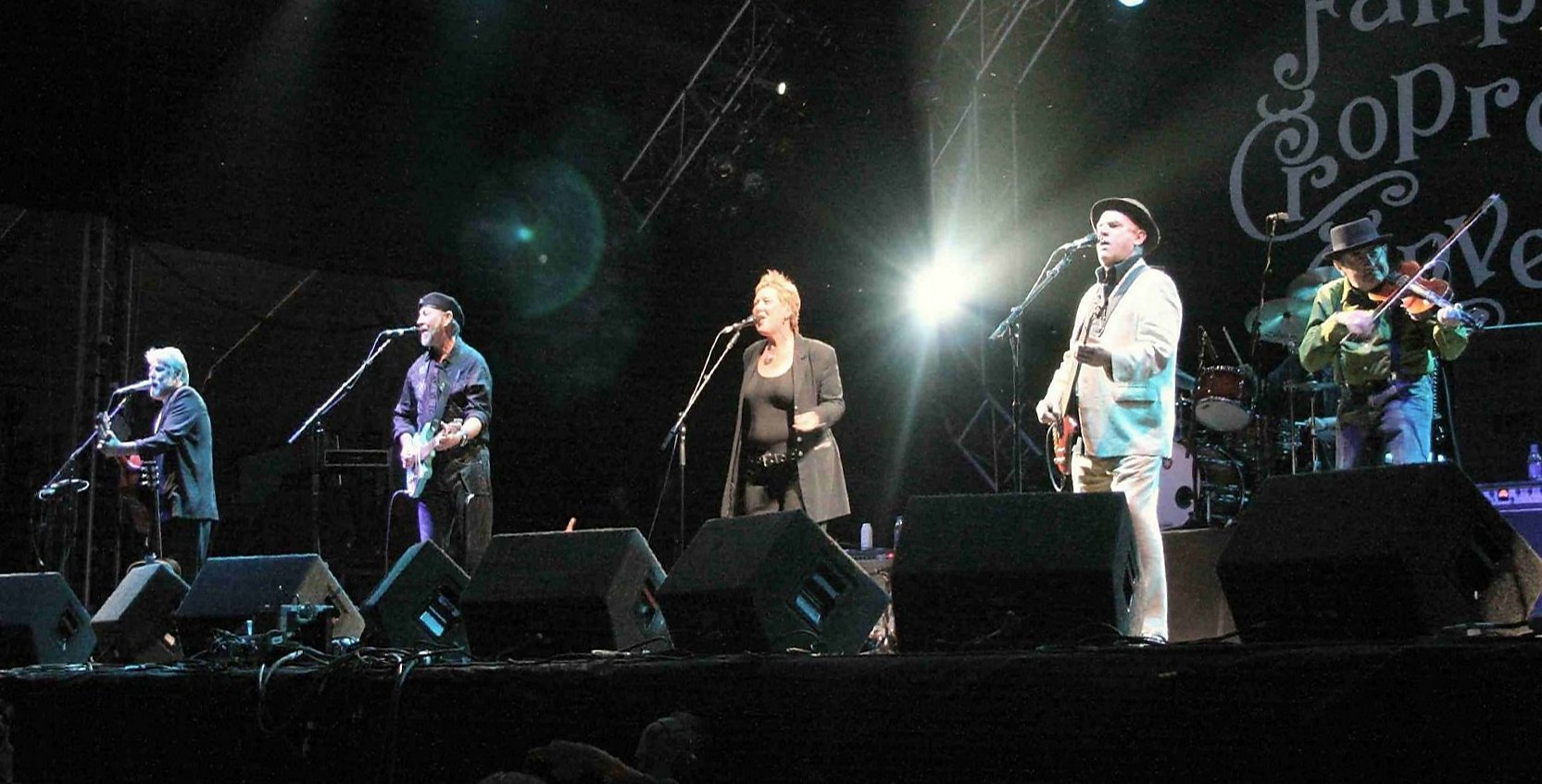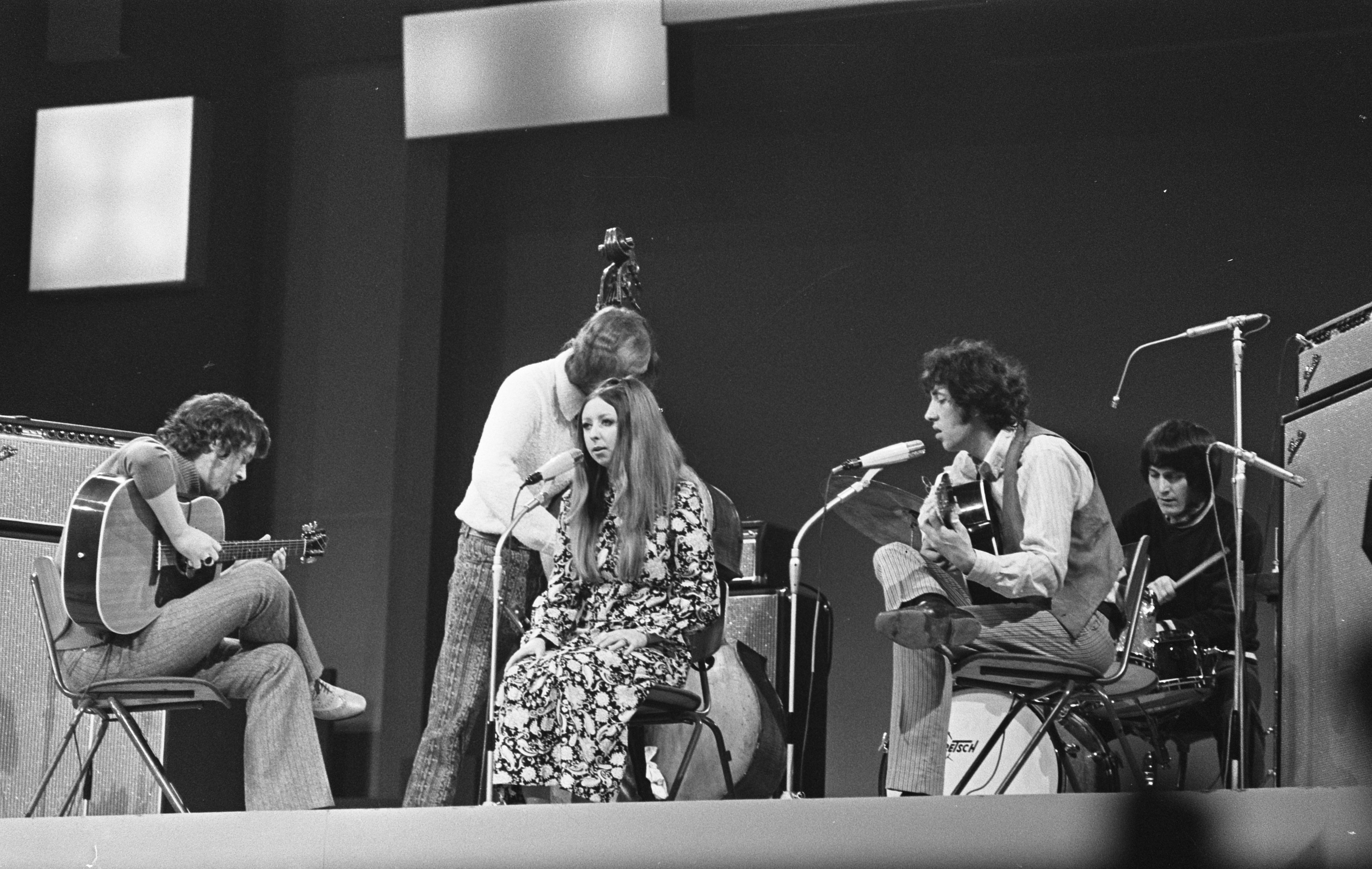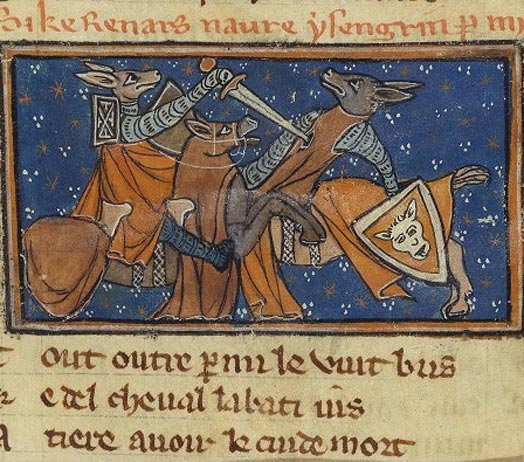|
Reynardine
Reynardine is a traditional English ballad (Roud 397). In the versions most commonly sung and recorded today, Reynardine is a werefox who attracts beautiful women so that he can take them away to his castle. What fate meets them there is usually left ambiguous. The Mountains High The original English ballads upon which Reynardine are based, most of which date to the Victorian era, are generally found under the title The Mountains High. In the original story, Ranordine (also given as Rinordine, Rinor Dine, Ryner Dyne, Rine-a-dine, Rynadine, Retterdyne, Randal Rhin or Randal Rine) is a bandit or outlaw who encounters a young woman in the wilderness and seduces or abducts her. The song ends with a warning to young women to beware of strange men. "The Mountains High" appears not to be very old, since only one version was collected before 1800. A version appears in George Petrie's 1855 collection of ballads; other variants appear in a number of broadside ballads from the nineteenth ... [...More Info...] [...Related Items...] OR: [Wikipedia] [Google] [Baidu] |
Liege & Lief
''Liege & Lief'' is the fourth album by the British folk rock band Fairport Convention. It is the third album the group released in the UK during 1969, all of which prominently feature Sandy Denny as lead female vocalist (Denny did not appear on the group's 1968 debut album), as well as the first to feature future long-serving personnel Dave Swarbrick and Dave Mattacks on violin/mandolin and drums, respectively, as full band members (Swarbrick had previously guested on ''Unhalfbricking''). It is also the first Fairport album on which all songs are either adapted (freely) from traditional British and Celtic folk material (for example "Matty Groves", "Tam Lin"), or else are original compositions (such as "Come All Ye", "Crazy Man Michael") written and performed in a similar style. Although Denny and founding bass player Ashley Hutchings quit the band before the album's release, Fairport Convention has continued to the present day to make music strongly based within the British folk ... [...More Info...] [...Related Items...] OR: [Wikipedia] [Google] [Baidu] |
Bert Jansch
Herbert Jansch (3 November 1943 – 5 October 2011) was a Scottish folk musician and founding member of the band Pentangle. He was born in Glasgow and came to prominence in London in the 1960s as an acoustic guitarist and singer-songwriter. He recorded more than 28 albums and toured extensively from the 1960s to the 21st century. Jansch was a leading figure in the 1960s British folk revival, touring folk clubs and recording several solo albums, as well as collaborating with other musicians such as John Renbourn and Anne Briggs. In 1968, he co-founded the band Pentangle, touring and recording with them until their break-up in 1972. He then took a few years' break from music, returning in the late 1970s to work on a series of projects with other musicians. He joined a reformed Pentangle in the early 1980s and remained with them as they evolved through various changes of personnel until 1995. Until his death, Jansch continued to work as a solo artist. Jansch's work influenced ... [...More Info...] [...Related Items...] OR: [Wikipedia] [Google] [Baidu] |
Folk Roots, New Routes
''Folk Roots, New Routes'' is a collaborative folk album by Shirley Collins and Davy Graham, released by Decca in 1964. The album was produced by Ray Horricks and recorded by Gus Dudgeon; the sleeve featured a photograph by Crispian Woodgate and sleeve notes by Austin John Marshall. According to Bob Stanley, the album took inspiration from the North African scale, modal music and Miles Davis; it was the first time many of these English folk songs had been recorded with guitar backing. Track listing Personnel * Shirley Collins: vocals; five-string banjo ("The Cherry Tree Carol") * Davy Graham: guitar Reception ''Folk Roots, New Routes'' is regarded as a landmark album of the folk revival; Jude Rogers writing for NPR called it "an uncompromising work that spearheaded innovation in the middle of the folk music revival. It set a template for the folk-rock that followed it, and inspired 21st century psych-folk decades later." It is described as a template for Fairport Conventi ... [...More Info...] [...Related Items...] OR: [Wikipedia] [Google] [Baidu] |
Rosemary Lane (album)
''Rosemary Lane'' is the seventh album by contemporary British folk musician Bert Jansch, released in 1971. The sleeve was designed by Heather Jansch Heather Jansch (born Heather Rosemary Sewell) was a British sculptor notable for making life-sized sculptures of horses from driftwood. Jansch reported that she struggled in her youth academically, but had a passion for drawing and writing. She .... Track listing References Bert Jansch albums 1971 albums Albums produced by Bill Leader Transatlantic Records albums {{1970s-folk-album-stub ... [...More Info...] [...Related Items...] OR: [Wikipedia] [Google] [Baidu] |
Anne Briggs (album)
''Anne Briggs'' is a folk album released in 1971 by Anne Briggs. The songs are Traditional apart from two Briggs originals, "Go Your Way" and "Living By The Water". The front cover photograph was taken by Pat Delap on Little Bealings Heath, Suffolk either in 1969 or 1970. Release history In 2009, " Blackwater Side" was included in Topic Records 70 year anniversary boxed set ''Three Score and Ten'' as track four of the second CD in the set. On Record Store Day 2015 Topic records re-released the album on 180g vinyl. Track listing All tracks are traditional; arranged by Anne Briggs; except where noted. #" Blackwater Side" - 3:53 #" The Snow It Melts The Soonest" - 2:23 #" Willie O'Winsbury" - 5:31 #"Go Your Way" (Anne Briggs, Bert Jansch) - 4:14 #"Thorneymoor Woods" - 3:36 #" The Cuckoo" - 3:11 #"Reynardine Reynardine is a traditional English ballad (Roud 397). In the versions most commonly sung and recorded today, Reynardine is a werefox who attracts beautiful women so that ... [...More Info...] [...Related Items...] OR: [Wikipedia] [Google] [Baidu] |
Fire & Fleet & Candlelight
''Fire & Fleet & Candlelight'' is the fourth album by Cree singer and songwriter Buffy Sainte-Marie. More than its predecessor '' Little Wheel Spin and Spin'', it marked a significant departure from the simple folk songs of her first two albums. Following the same path that Joan Baez and Judy Collins were taking at the time, Sainte-Marie relies on the orchestration of Peter Schickele on "Summer Boy", "The Carousel" and "Hey Little Bird". In contrast, " The Circle Game" and "97 Men in This Town Would Give a Half a Grand in Silver Just to Follow Me Down" feature for the first time a full rock band consisting of Bruce Langhorne on electric guitar, Alexis Rogers on drums and Russ Savakus on bass. "Song to a Seagull", the other Joni Mitchell song, is a much simpler voice-and-guitar rendition. Her version of the traditional hymn "Lyke Wake Dirge" predates the version by Pentangle by over two years and the album's title is taken from one of the lines in that song's chorus. "T'es pas un ... [...More Info...] [...Related Items...] OR: [Wikipedia] [Google] [Baidu] |
Herbert Hughes (musicologist)
Herbert Hughes (16 May 1882 – 1 May 1937) was an Irish composer, music critic and a collector and arranger of Irish folksongs. He was the father of Spike Hughes. Biography Hughes was born and brought up in Belfast, Ireland, but completed his formal music education at the Royal College of Music, London, where he studied with Charles Villiers Stanford and Charles Wood, graduating in 1901. Subsequently, he worked as a music critic, notably for ''The Daily Telegraph'' from 1911 to 1932. Described as having an "ardent and self-confident manner", Hughes is first heard of in an Irish musical capacity (beyond being honorary organist at St Peter's Church on Antrim Road at the age of fourteen) collecting traditional airs and transcribing folksongs in North Donegal in August 1903 with his brother Fred, F.J. Bigger, and John Campbell. Dedicated to seeking out and recording such ancient melodies as were yet to be found in the more remote glens and valleys of Ulster, he produced ''Songs ... [...More Info...] [...Related Items...] OR: [Wikipedia] [Google] [Baidu] |
Reynard
Reynard the Fox is a literary cycle of medieval allegorical Dutch, English, French and German fables. The first extant versions of the cycle date from the second half of the 12th century. The genre was popular throughout the Late Middle Ages, as well as in chapbook form throughout the Early Modern period. The stories are largely concerned with the main character Reynard, an anthropomorphic red fox, trickster figure. His adventures usually involve his deceiving other anthropomorphic animals for his own advantage or trying to avoid their retaliatory efforts. His main enemy and victim across the cycle is his uncle, the wolf, Isengrim (or Ysengrim). While the character of Reynard appears in later works, the core stories were written during the Middle Ages by multiple authors and are often seen as parodies of medieval literature such as courtly love stories and chansons de geste, as well as a satire of political and religious institutions.Bianciotto, G. (2005). Introduction. In ' ... [...More Info...] [...Related Items...] OR: [Wikipedia] [Google] [Baidu] |
English Folklore
English folklore consists of the myths and legends of England, including the English region's mythical creatures, traditional recipes, urban legends, proverbs, superstitions, and folktales. Its cultural history is rooted in Celtic, Christian, and Germanic folklore. During the Renaissance in the 16th century, England looked to more European texts to develop a national identity. English folklore has continued to differ according to region, although there are shared elements across the country. Its folktales include the traditional Robin Hood tales and the Brythonic-inspired Arthurian legend, and their stories often contained a moral imperative stemming from Christian values. The folktales, characters and creatures are often derived from aspects of English experience, such as topography, architecture, real people, or real events. History Before England was founded in the year 927, Wessex and its surrounding areas' cultures were transformed by the invasion of the Danish Kin ... [...More Info...] [...Related Items...] OR: [Wikipedia] [Google] [Baidu] |
Anne Briggs
Anne Patricia Briggs (born 29 September 1944) is an English folk singer. Although she travelled widely in the 1960s and early 1970s, appearing at folk clubs and venues in England and Ireland, she never aspired to commercial success or to achieve widespread public acknowledgment of her music. However, she was an influential figure in the British folk revival, being a source of songs and musical inspiration for others such as A. L. Lloyd, Bert Jansch, Jimmy Page, The Watersons, June Tabor, Sandy Denny, Richard Thompson, and Maddy Prior. Early life Briggs was born in Toton, Beeston, Nottinghamshire, England. Her mother died of tuberculosis when she was young. Her father, Albert, was severely injured in World War II and she was raised in Toton by her aunt Hilda and uncle Bill, who also brought up Hilda's youngest sister Beryl, and their own daughter Betty. In 1959, she hitch-hiked with a friend to Edinburgh. They stayed overnight with Archie Fisher, who was at that time prominent ... [...More Info...] [...Related Items...] OR: [Wikipedia] [Google] [Baidu] |
Dave Swarbrick
David Cyril Eric Swarbrick (5 April 1941 – 3 June 2016) was an English folk musician and singer-songwriter. His style has been copied or developed by almost every British and many world folk violin players who have followed him. He was one of the most highly regarded musicians produced by the second British folk revival, contributing to some of the most important groups and projects of the 1960s, and he became a much sought-after session musician, which led him throughout his career to work with many of the major figures in folk and folk rock music. A member of Fairport Convention from 1969, he is credited with assisting them to produce their seminal album ''Liege & Lief'' (1969) which initiated the British folk rock movement. This, and his subsequent career, helped create greater interest in British traditional music and was highly influential within mainstream rock. After 1970 he emerged as Fairport Convention's leading figure and guided the band through a series of i ... [...More Info...] [...Related Items...] OR: [Wikipedia] [Google] [Baidu] |
Martin Carthy
Martin Carthy MBE (born 21 May 1941) is an English folk singer and guitarist who has remained one of the most influential figures in British traditional music, inspiring contemporaries such as Bob Dylan and Paul Simon, and later artists such as Richard Thompson, since he emerged as a young musician in the early days of the folk revival in the UK during the 1960s and 1970s. Early life He was born in Hatfield, Hertfordshire, England, and grew up in Hampstead, North West London. His mother was an active socialist and his father, from a family of Thames lightermen, went to grammar school and became a trade unionist and a councillor for Stepney at the age of 21. Martin's father had played fiddle and guitar as a young man but Martin was unaware of this connection to his folk music heritage until much later in life. His vocal and musical training began when he became a chorister at the Queen's Chapel of The Savoy. He picked up his father's old guitar for the first time after hearing ... [...More Info...] [...Related Items...] OR: [Wikipedia] [Google] [Baidu] |




_-_TopPop_1972.png)
.jpg)